Tag: what is resource development class 10
Resources and Development Class 10 Notes of NCERT Geo. Ch. 1
Welcome to our exclusive and comprehensive guide on “Resources and Development Class 10 Notes.” If you’re a Class 10 student looking to excel in your geography studies or an eager learner seeking a deeper understanding of resources and their development, you’ve landed on the perfect page.
The subject of “Resources and Development” is a fundamental aspect of geography, encompassing the exploration, distribution, and sustainable use of various resources that shape our world. From understanding the significance of natural resources like water, minerals, and forests to analyzing the impact of human activities on the environment, this topic holds immense relevance in today’s context.
In the article, “Resources and Development Class 10 Notes” we have meticulously curated notes and study materials that cater specifically to Class 10 students. Say goodbye to overwhelming textbooks and disjointed online resources; here, we present the information in a clear, concise, and student-friendly manner. Join us on this enlightening journey as we equip you with the knowledge and insights needed to conquer your exams and gain a deeper appreciation for the intricate workings of our planet. Let’s dive in!
Resources and Development Class 10 Notes
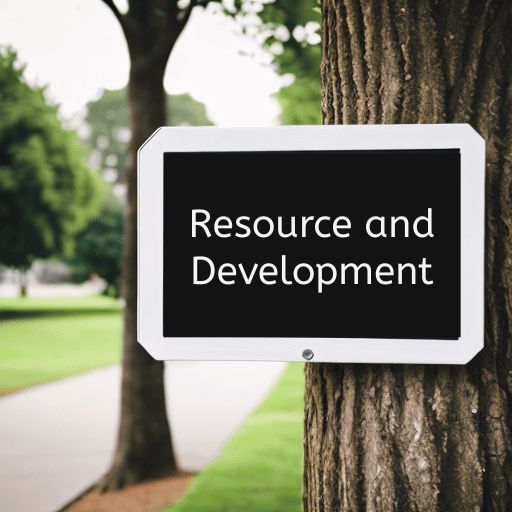
Topics in Resources and Development Class 10 Chapter 1
- Resources
- Classification of Resources
- On the basis of origin
- On the Basis of Exhaustibility
- On the Basis of Ownership
- On the Basis of the Status of Development
- Development of Resources
- Resource Planning
- Land Resources
- Land Resources in India
- Land Use Pattern in India
- Land Degradation and Conservation measures
- Soil as a Resource
- Classification of Soils
- Alluvial Soils
- Black Soil
- Red and Yellow Soils
- Laterite Soils
- Arid Soils
- Forest Soils
- Soil Erosion and Soil Conservation
Resources and Development Class 10 Notes
Resources
The term “Resource” encompasses everything in our environment that satisfies our needs, is technologically accessible, economically feasible, and culturally acceptable. Interestingly, human beings themselves are integral components of these resources.
They play a vital role in transforming materials available in the environment into valuable resources and subsequently utilize them for various purposes. This intricate process of conversion and utilization highlights the dynamic relationship between humanity and its surroundings, showcasing our ability to adapt and harness the elements of nature to meet our requirements effectively.
As we delve into the concept of resources, we begin to realize the profound impact our actions have on the environment, underlining the importance of sustainable practices to ensure a harmonious coexistence with the natural world.
Classification of Resources
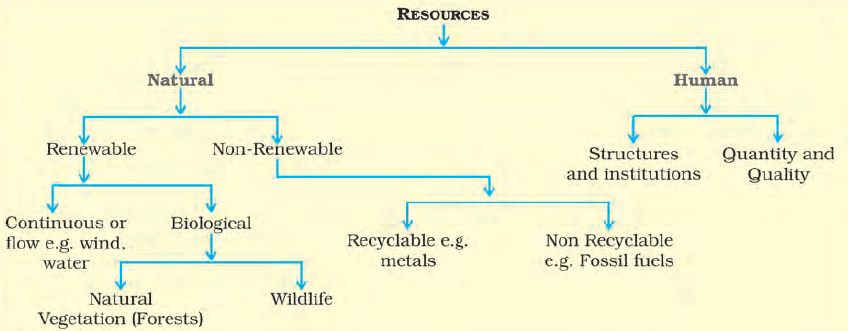
(a) Based on their Origin –
Biotic and Abiotic
Biotic Resources are derived from the biosphere and encompass all living organisms such as human beings, flora, fauna, fisheries, and livestock.
Example: Human populations, plant life, animals, aquatic life, etc.
Abiotic Resources, on the other hand, consist of non-living elements like rocks and metals.
Example: Minerals, ores, rocks, metals, etc.
(b) Based on Exhaustibility –
Renewable and Non-Renewable
Renewable or Replenishable Resources can be replenished or reproduced through natural processes, such as solar and wind energy, water, forests, and wildlife.
Example: Solar energy, wind power, water resources, etc.
Non-Renewable Resources take millions of years to form and cannot be readily replaced. Some non-renewable resources, like metals, are recyclable, while others, like fossil fuels, are exhausted with use.
Example: Fossil fuels (coal, oil, natural gas), minerals (iron, copper, gold), etc.
(c) Based on Ownership –
Individual, Community, National, and International
Individual Resources are privately owned by individuals and include lands, plots, houses, and other properties.
Example: Private estates, personal farms, etc.
Community Owned Resources are accessible to all members of a community and may include grazing grounds, public parks, and picnic spots.
Example: Village common lands, community parks, etc.
National Resources are owned by a nation or country, including minerals, water resources, forests, and land within its political boundaries.
Example: National parks, railways, etc.
International Resources are regulated by international institutions and encompass oceanic resources beyond 200 nautical miles of the Exclusive Economic Zone.
Example: Open ocean resources, international waters, etc.
(d) Based on the Status of Development –
Potential, Developed Stock, and Reserves
Potential Resources are available in a region but remain untapped or underutilized.
Example: Untapped wind and solar energy potential in certain regions.
Developed Resources have been surveyed, and their quantity and quality have been determined for utilization based on technology and feasibility.
Example: Extracted minerals, available water sources, etc.
Stocks are materials in the environment with potential to meet human needs, but current technology does not allow access.
Example: Hydrogen as a rich energy source without advanced utilization technology.
Reserves are a subset of stocks that can be utilized with existing technology but have not yet been put into use.
Example: Water stored in dams, untapped forest resources, etc.
Understanding these classifications helps us appreciate the diverse nature of resources and guides us in responsible and sustainable resource management for a better future.
Development of Resources
The indiscriminate use of resources by human beings has given rise to significant challenges, causing the following major problems:
1. Depletion of Resources: Many resources have been exploited without restraint to fulfill the greed of a few individuals. This uncontrolled consumption has led to the exhaustion of valuable resources, threatening the balance of ecosystems and natural cycles.
2. Unequal Distribution: As resources accumulate in the hands of a privileged few, societal divisions have intensified, creating a stark contrast between the wealthy and the impoverished. This economic disparity can perpetuate social inequalities and hinder overall progress.
3. Global Ecological Crises: The unregulated use of resources has triggered severe ecological crises on a global scale. Issues like global warming, ozone layer depletion, environmental pollution, and land degradation pose severe threats to the environment and all forms of life.
To address these challenges and ensure a sustainable future, resource planning becomes indispensable. Sustainable economic development aims to strike a harmonious balance between human progress and environmental preservation. It emphasizes the importance of developing without causing harm to the environment and ensuring that the needs of future generations are not compromised.
By implementing thoughtful resource management strategies, we can safeguard the well-being of both current and future generations while preserving the natural world for all life forms to thrive.
Resource Planning
In India, there exists a diverse landscape where some regions boast self-sufficiency in resources, while others face acute shortages of vital elements. To address this disparity, it becomes imperative to adopt a balanced resource planning approach at the national, state, regional, and local levels.
Resource Planning in India is a multifaceted process involving the following key steps:
(i) Identification and Inventory: An extensive survey, mapping, and qualitative as well as quantitative estimation of resources are conducted across the country’s various regions. This comprehensive assessment aids in understanding the resource distribution.
(ii) Planning Structure: A well-endowed planning structure is developed, incorporating appropriate technology, skills, and institutional setups to effectively implement resource development plans.
(iii) Alignment with National Development: Resource development plans are harmonized with the broader national development goals to ensure synergy and optimal utilization.
For resources to contribute effectively to development, it is crucial to accompany them with appropriate technological advancements and institutional changes. India has been actively pursuing resource planning since the inception of the First Five Year Plan after Independence, showcasing its commitment to sustainable growth.
To combat irrational consumption and over-utilization of resources, conservation efforts at various levels play a pivotal role in preserving the environment and fostering a sustainable future. By embracing resource planning and conservation, India can pave the way towards a balanced and prosperous tomorrow for all its citizens.
Land Resources

Land stands as a paramount natural resource, bearing immense significance in its support for various aspects of life and development. It sustains natural vegetation, wildlife, human settlements, economic activities, as well as transportation and communication systems. India’s landscape comprises a diverse array of relief features, encompassing mountains, plateaus, plains, and islands, as illustrated below:
Land Utilisation
Land resources find application in the following purposes:
1. Forests: Land is allocated for the growth and preservation of forests, vital for ecological balance and biodiversity conservation.
2. Land not available for cultivation: This category includes two subtypes:
a) Barren and wasteland: Land that is unsuitable for agricultural activities due to its arid or unproductive nature.
b) Land put to non-agricultural uses: Land utilized for non-farming purposes such as residential, industrial, or infrastructural developments.
3. Fallow lands: These are lands that are temporarily left uncultivated to regain fertility or due to seasonal reasons.
4. Other uncultivated lands (excluding fallow land): Lands that are not cultivated, excluding those explicitly categorized as fallow.
5. Net sown area: The total land area under cultivation, which excludes the area under fallow and uncultivated land.
Understanding and efficiently utilizing land resources across these diverse purposes are essential for sustainable development and optimal land management.
Land Use Pattern in India
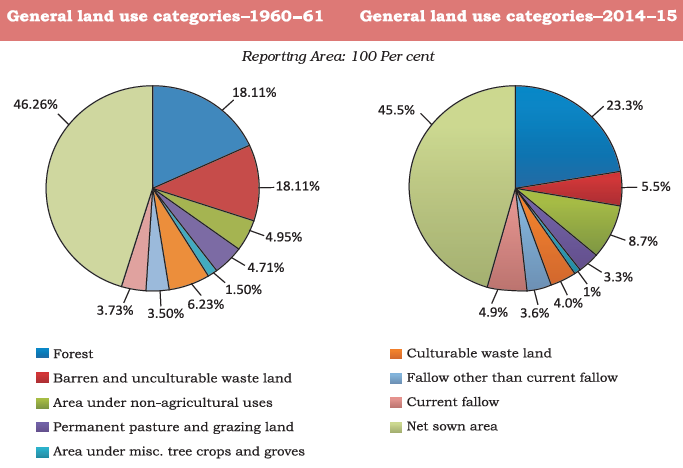
The utilization of land is influenced by two main sets of factors:
1. Physical Factors: These encompass various elements that are inherent to the land itself, such as topography (terrain features and elevation), climate (temperature, precipitation, etc.), and soil types (fertility, composition, etc.). These physical characteristics significantly impact the suitability and productivity of the land for various activities.
2. Human Factors: These factors relate to human interactions and decisions concerning land use. They include population density (the concentration of people in a specific area), technological capability (the level of technology available for land development and utilization), as well as culture and traditions, which influence the practices and preferences related to land use in a given society.
The interplay between these physical and human factors shapes how land is allocated and utilized for different purposes, ranging from agriculture and settlements to industrial and recreational activities. Understanding and balancing these factors are crucial for effective land management and sustainable development.
Wasteland refers to land that is utilized for non-agricultural purposes, encompassing areas characterized by rockiness, aridity, deserts, as well as spaces allocated for roads, railways, industries, and other non-farming activities. Unfortunately, the prolonged and unregulated use of land without implementing adequate conservation and management measures has led to the degradation of land resources.
As a consequence of this continuous usage, land degradation occurs, impacting the quality and fertility of the soil, reducing its ability to support vegetation and sustainable activities. It is essential to adopt responsible land management practices to counteract this degradation, ensuring the preservation and rejuvenation of our valuable land resources for future generations. Through proactive conservation efforts, we can combat the detrimental effects and promote sustainable land use, thus safeguarding the ecological balance and productivity of our lands.
Land Degradation and Conservation Measures
Land degradation is primarily driven by human activities, including deforestation, overgrazing, mining, and quarrying. These practices have left lasting impacts on the land, evident in deep scars and overburdened areas at mining sites. Additionally, industrial effluents have emerged as significant contributors to land and water pollution in various regions across the country.
Various soil conservation techniques are implemented to combat soil erosion and safeguard fertile land.
1. Afforestation and Grazing Management: Promoting afforestation initiatives and adopting proper grazing management practices help restore vegetation cover and prevent soil erosion.
2. Shelter Belt Planting: Creating shelter belts of plants can serve as protective barriers against wind and soil erosion, enhancing the stability of the land.
3. Sand Dune Stabilization: Growing thorny bushes on sand dunes aids in stabilizing them and curbing the encroachment of desertification.
4. Wasteland Management: Implementing comprehensive plans for the management of wastelands ensures their optimal utilization and potential for reclamation.
5. Control of Mining Activities: Regulating and controlling mining activities can minimize the adverse impacts on land, promoting sustainable extraction practices.
6. Industrial Effluent Treatment: Ensuring proper treatment and disposal of industrial effluents and wastes help mitigate land and water pollution, safeguarding the environment.
By implementing these proactive measures, we can combat land degradation and preserve the productivity and ecological health of our land resources. Emphasizing responsible land management practices is vital to secure a sustainable future for our environment and generations to come.
Soil as a Resource
Soil stands as the most crucial renewable natural resource, serving as the vital medium for plant growth and supporting diverse life forms on our planet.
The formation of soil is an incredibly slow process, taking millions of years to develop just a few centimeters in depth. Nature’s various forces, including temperature fluctuations, the actions of running water, wind, glaciers, and the activities of decomposers, all contribute to the gradual formation of soil.
Several key factors play significant roles in soil formation, such as the composition of the parent rock or bedrock, the prevailing climate, the types of vegetation, other living organisms, and the passage of time. Through a combination of chemical and organic changes, soil evolves, enriching its composition and supporting its essential functions.
Soil consists of both organic matter, commonly known as humus, and inorganic materials. This unique combination of components contributes to the soil’s fertility, making it an indispensable resource for sustaining life and fostering a wide array of ecosystems on Earth.
Classification of Soils
India’s diverse soils are classified based on factors such as soil formation, color, thickness, texture, age, and chemical and physical properties. Different types of soils found in India are:
1. Alluvial Soils:

– Found in the northern plains, as well as Rajasthan, Gujarat, and eastern coastal plains.
– Deposited by important Himalayan rivers like the Indus, Ganga, and Brahmaputra.
– Divided into Old Alluvial (Bangar) and New Alluvial (Khadar) based on age.
– Very fertile, ideal for growing crops like sugarcane, paddy, wheat, and pulses.
2. Black Soil:
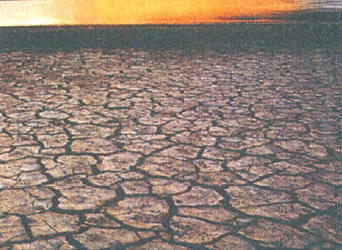
– Also known as regur soil, found in Deccan trap (Basalt) regions.
– Ideal for cotton cultivation due to its moisture-retaining capacity.
– Rich in nutrients like calcium carbonate, magnesium, potash, and lime.
3. Red and Yellow Soils:
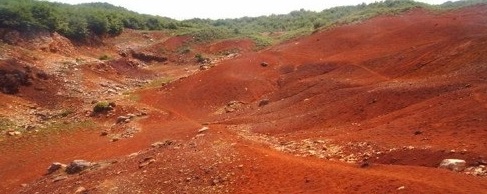
– Develop on crystalline igneous rocks in areas of low rainfall.
– Get their reddish color from iron diffusion in crystalline rocks.
– Found in parts of Odisha, Chhattisgarh, and southern regions of the Deccan plateau.
4. Laterite Soil:
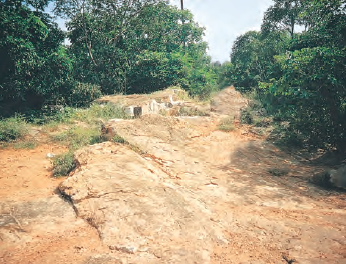
– Found in tropical and subtropical climates with alternating wet and dry seasons.
– Result of intense leaching due to heavy rain, making it acidic and nutrient-deficient.
– Suitable for tea and coffee cultivation and supports deciduous and evergreen forests.
5. Arid Soils:
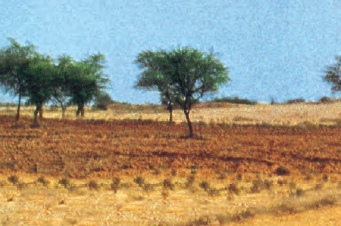
– Ranging from red to brown in color, found in arid regions.
– Sandy texture with high saline content, lacking in humus and moisture.
– Kankar layer restricts water infiltration.
6. Forest Soils:
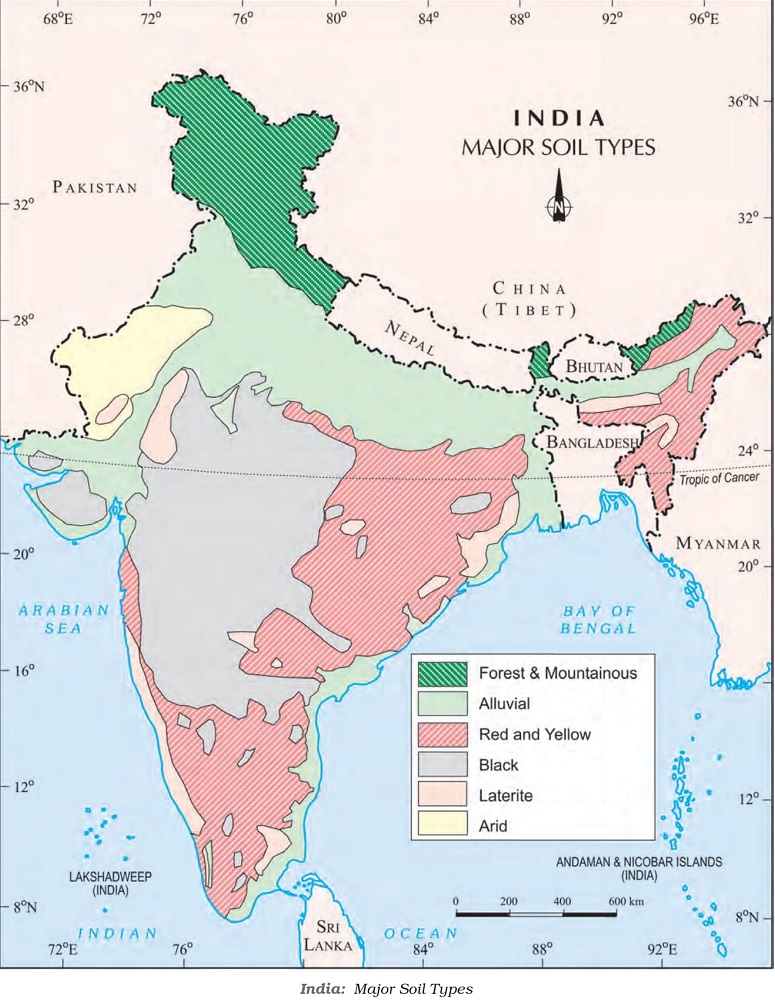
– Located in hilly and mountainous areas with varied textures based on elevation.
– Snow-covered areas in the Himalayas have acidic soils with low humus content.
– Fertile on river terraces and alluvial fans.
Each type of soil supports different ecosystems and is vital for agricultural productivity in its respective region. Understanding and managing these soils are crucial for sustainable land use and successful agricultural practices across the country.
Soil Erosion and Soil Conservation
Soil erosion, resulting from the denudation and subsequent washing down of the soil cover, poses a significant challenge. Deforestation, over-grazing, construction, and mining are the cause of erosion. Natural forces like wind, glaciers, and water. Defective farming methods also contribute to soil erosion.
Various forms of soil erosion occur depending on the terrain and circumstances. Running water carves deep channels known as gullies in clayey soils, rendering the land unsuitable for cultivation and termed as bad land.
To combat soil erosion and preserve fertile land, different soil conservation techniques are employed:
1. Contour Ploughing: Ploughing along the contour lines slows down water flow on slopes, reducing erosion.
2. Terrace Cultivation: Practiced in the Western and Central Himalayas, terrace cultivation helps control erosion.
3. Strip Cropping: Grass is grown between strips of large fields to break the force of the wind and minimize erosion.
4. Shelter Belts: Planting lines of trees to create shelter aids in stabilizing sand dunes and desert areas, particularly in western India.
By adopting these soil conservation methods, we can protect valuable topsoil, maintain fertile land for agriculture, and safeguard the environment from the adverse effects of soil erosion. Keep exploring and stay updated on CBSE and NCERT-related information. Access interactive Maths and Science videos through the BYJU’S App and subscribe to their YouTube channel for continuous learning.
Summery of the Article Resources and Development Class 10 Notes
The summary introduces an exclusive and comprehensive guide on “Resources and Development Class 10 Notes,” catering to Class 10 students seeking a deeper understanding of resources and their development. The article emphasizes the importance of resources for human survival, development, and progress.
The summary further delves into land resources, soil as a vital renewable natural resource, and the classification of soils in India. It concludes by addressing soil erosion and soil conservation measures.
Read Also:
Frequently Asked Questions on CBSE Resources and Development Class 10 Notes
Q 1. Importance of resources and development chapter for class 10 students?
The “Resources and Development” chapter is vital for Class 10 students as it introduces foundational knowledge about various resources, their distribution, and utilization.
It enhances environmental awareness, understanding the implications of human activities on the planet. Students learn about the economic significance of resources and their role in sustainable development. This knowledge fosters global perspective, encouraging responsible resource management.
Additionally, it equips students to analyze policies, participate in discussions, and advocate for environmentally conscious decisions. Mastering this chapter ensures excellent exam preparation while empowering students to become informed and proactive citizens, contributing to a sustainable future for our world.
Q 2. Importance of resources for humans?
Resources are of utmost importance for humans as they are essential for survival, development, and progress. Natural resources like water, air, soil, minerals, and energy sources provide the necessary elements for human sustenance, economic activities, and technological advancements.
They are vital for agriculture, industries, infrastructure, and daily living. Human civilization thrives on the availability and efficient utilization of resources, shaping societies, economies, and lifestyles.
Understanding and managing resources sustainably are crucial to ensure a better quality of life, economic prosperity, and environmental conservation. Recognizing the importance of resources empowers us to make responsible decisions, preserve nature’s gifts, and secure a better future for generations to come.
Q 3. How to protect natural resources?
Protecting natural resources requires a concerted effort and a collective commitment to sustainable practices. Some key measures include:
- Conservation and Preservation: Implementing conservation strategies like afforestation, reforestation, and protected areas helps maintain biodiversity and prevent resource depletion.
- Responsible Consumption: Promote responsible consumption habits, reduce waste, and practice recycling to minimize resource exploitation and environmental impact.
- Sustainable Agriculture: Adopt sustainable agricultural practices that preserve soil fertility, minimize chemical usage, and promote crop rotation for long-term resource preservation.
- Efficient Energy Use: Promote energy efficiency, transition to renewable energy sources, and reduce reliance on fossil fuels to conserve natural resources.
- Water Conservation: Encourage responsible water usage, rainwater harvesting, and the protection of water bodies to preserve this vital resource.
By integrating these measures into our lifestyles and policies, we can safeguard natural resources, promote ecological harmony, and ensure a sustainable future for generations to come.